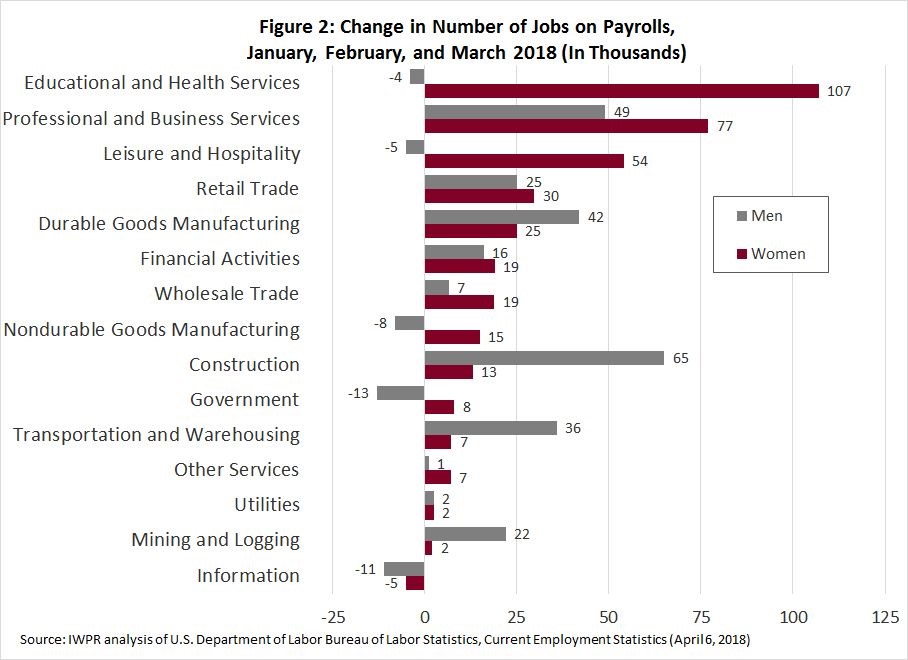Unemployment Remains Steady At 4.1 Percent, But Black Men and Women Have Seen Declines in Past Year

The Institute for Women’s Policy Research (IWPR) analysis of the April employment report from the U.S. Bureau of Labor Statistics (BLS) establishment survey finds that in March women added 83,000 jobs and men gained just 20,000 jobs for a total of 103,000 jobs added to payrolls in March. In the first three months of 2018 (January-March), men gained 37 percent (225,000 jobs) and women gained 63 percent (380,000 jobs) of all jobs added (605,000 jobs). According to the household survey, the overall unemployment rate remained steady at 4.1 percent across all three months in the first quarter of 2018.
In March, women gained jobs in Educational and Health Services (41,000 jobs added for women) and Professional and Business Services (19,000 jobs added for women), and Leisure and Hospitality (14,000 jobs added for women), but lost jobs in Retail Trade (19,200 jobs lost for women), Other Services (2,000 jobs lost for women), and Construction (1,000 jobs lost for women). Men gained jobs in Retail Trade (14,800 jobs added for men), Professional and Business Services (14,000 jobs added for men), and Durable Goods Manufacturing (12,000 jobs added for men), but lost jobs in in Educational and Health Services (16,000 jobs lost for men), Construction (14,000 jobs lost for men), and Leisure and Hospitality (9,000 jobs lost for men).

Figure 2 shows that in the first three months of 2018 (January-March), women’s job gains were strongest in Educational and Health Services (107,000 jobs added for women), Professional and Business Services (77,000 jobs added for women), and Leisure and Hospitality (54,000 jobs added for women). However, during this period, women lost jobs in Information (5,000 jobs lost for women). Over the same time period, men’s job gains were strongest in Construction (65,000 jobs added for men), Professional and Business Services (49,000 jobs added for men), and Durable Goods Manufacturing (42,000 jobs added for men). Men’s job losses were largest in Government (13,000 jobs lost for men) and Information (11,000 jobs lost for men).
According to the household survey data reported by the BLS, the overall labor force participation rate (which is the sum of the employed and unemployed divided by the total population aged 16 and older) decreased to 62.9 percent in March from 63.0 percent in February. In March, women 16 and older had a labor force participation rate of 56.9 percent and men 16 and older had a labor force participation rate of 69.3 percent. Unemployment among women aged 16 and older was 4.0 percent in March compared to 4.1 percent among men aged 16 and older.

Among workers aged 20 and older in March 2018, unemployment is substantially higher among Black women (6.0 percent; Figure 3) and men (6.1 percent) compared with White women and men (3.2 percent and 3.3 percent, respectively). Hispanic women’s unemployment (4.9 percent) and Hispanic men’s unemployment (4.4 percent) are also higher than White women’s and men’s unemployment. In the previous year, unemployment declined for Black women (6.5 percent in March 2017 to 6.0 percent in March 2018), Black men (8.3 percent in March 2017 to 6.1 percent in March 2018), White women (3.5 percent in March 2017 to 3.2 percent in March 2018), and White men (3.6 percent in March 2017 to 3.3 percent in March 2018). However, unemployment increased for Hispanic women (4.7 percent in March 2017 to 4.9 percent in March 2018) and remained steady for Hispanic men (4.4 percent in March 2017 and March 2018).
For single mothers (female heads of households residing with at least one family member, but not an opposite-sex spouse), the unemployment rate decreased to 5.6 percent in March from 6.2 percent in February. Unemployment has changed little over the past year from 5.5 percent in March 2017. The unemployment rate for single mothers is not seasonally adjusted and can fluctuate due to small sample sizes in the household survey.
The number of unemployed workers decreased from February to March, from 6.7 million to 6.6 million. The number of long-term unemployed workers (those unemployed for 27 weeks or more) decreased to 1.3 million in March 2018—a drop of 3.1 percentage points from 23.4 percent in March 2017 to 20.3 percent of unemployment in March 2018. The number of involuntary part-time workers—those reporting that they work part-time due to unfavorable business conditions, inability to find full-time work, or seasonal declines in demand—was 5.0 million in March 2018, compared with 5.5 million in March 2017.
|
For more information on IWPR reports, please visit www.iwpr.org.
|
The Institute for Women’s Policy Research (IWPR) conducts and communicates research to inspire public dialogue, shape policy, and improve the lives and opportunities of women of diverse backgrounds, circumstances, and experiences. The Institute’s research strives to give voice to the needs of women from diverse ethnic and racial backgrounds across the income spectrum and to ensure that their perspectives enter the public debate on ending discrimination and inequality, improving opportunity, and increasing economic security for women and families. The Institute works with policymakers, scholars, and public interest groups to design, execute, and disseminate research and to build a diverse network of individuals and organizations that conduct and use women-oriented policy research. IWPR’s work is supported by foundation grants, government grants and contracts, donations from individuals, and contributions from organizations and corporations. IWPR is a 501(c)(3) tax-exempt organization that also works in affiliation with the Program on Gender Analysis in Economics at American University.



